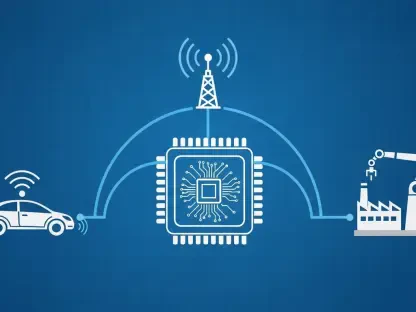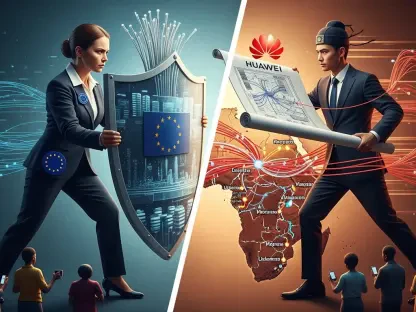In an era where technology evolves at breakneck speed, the global shift toward wireless connectivity has become undeniable, reshaping how people access the internet and interact with digital services. From smartphones to smart homes, wireless networks have surged in popularity, offering unparalleled convenience and speed that wired alternatives struggle to match. Yet, amidst this sweeping transformation, a perplexing trend persists in the United States: government policies and funding continue to prioritize fiber broadband infrastructure, often ignoring the dominance of wireless solutions. This disconnect raises critical questions about the alignment of public initiatives with modern technological realities. As private sector innovations drive connectivity to new heights, the stubborn focus on fiber by federal and state programs seems increasingly out of step with consumer needs and market dynamics, highlighting a gap between progress and policy that demands closer examination.
The Wireless Revolution Takes Hold
The ascent of wireless technology has fundamentally altered the digital landscape, with innovations like 5G networks delivering download speeds up to 20 times faster than their 4G LTE predecessors. This leap in performance has fueled a massive increase in data usage, as consumers and businesses alike embrace the flexibility of wireless internet for everything from streaming high-definition content to powering Internet of Things (IoT) devices. The shift away from traditional wired connections is evident in changing consumer behavior, with a significant drop in reliance on cable internet providers for home connectivity over recent years. Wireless options, including 5G home internet, have emerged as viable alternatives, offering ease of installation and mobility that fiber or cable cannot replicate. This trend reflects a broader recognition in the private sector that wireless is not just a passing fad but the cornerstone of future connectivity, driven by user demand for seamless, on-the-go access across diverse environments and applications.
Beyond speed and convenience, the wireless revolution is propelled by continuous advancements, with the anticipated rollout of 6G technology promising speeds up to 100 times faster than 5G. Such developments signal a long-term commitment to wireless as the dominant mode of internet access, evidenced by even traditional wired providers integrating Wi-Fi networks as standard in homes. This adaptation underscores a market consensus that wireless solutions better meet modern needs, particularly in urban and rural areas where laying fiber can be prohibitively expensive or logistically challenging. The private sector’s agility in responding to these shifts stands in sharp contrast to slower, more rigid public sector approaches, raising questions about why government initiatives have not kept pace. As wireless continues to redefine connectivity standards, the gap between private innovation and public policy becomes more pronounced, with significant implications for how resources are allocated to bridge digital divides effectively.
Government’s Persistent Fiber Focus
Despite the clear momentum behind wireless technology, U.S. government policies remain heavily invested in fiber broadband through initiatives like the $42.5 billion Broadband Equity, Access, and Deployment (BEAD) program. This substantial funding aims to expand high-speed internet access, yet a large portion—often around 80% in states like Louisiana and Virginia—is earmarked for fiber providers, even as wireless solutions prove more practical and cost-effective in many contexts. Critics argue that this emphasis on fiber overlooks the reality that nearly all Americans already have access to high-speed wireless internet, a milestone achieved by the private sector over a decade ago. The focus on fiber appears rooted in outdated assumptions about connectivity needs, ignoring the flexibility and scalability that wireless networks offer in addressing remaining coverage gaps, especially in hard-to-reach areas where fiber installation costs can soar.
Further scrutiny reveals that the government’s fiber-centric approach is not only misaligned with current trends but also inefficient in execution. The BEAD program, despite years of operation and billions in funding, had connected zero individuals as of late last year, highlighting a troubling lack of results. Connection costs for fiber can exceed $10,000 per household in some regions, a stark contrast to the lower overhead of wireless alternatives that can cover wide areas with fewer infrastructure demands. This financial burden, coupled with the slow rollout, suggests that public funds are being allocated to a technology that is less adaptable to modern demands. As private companies continue to innovate and expand wireless coverage, the government’s insistence on fiber risks wasting resources on redundant infrastructure, diverting attention from more pressing needs like cybersecurity or digital literacy programs that could complement existing connectivity achievements.
Bridging the Policy and Technology Gap
The disparity between the private sector’s embrace of wireless and the government’s fiber fixation points to a broader issue of policy lagging behind technological progress. This misalignment is not merely a matter of preference but a significant misstep in resource allocation, as billions of dollars are funneled into projects that fail to address the realities of today’s digital ecosystem. A more balanced approach could involve reallocating a portion of broadband funding to support wireless initiatives, particularly in underserved regions where speed of deployment is critical. Encouraging public-private partnerships could also leverage industry expertise to ensure that government efforts align with market-driven solutions, maximizing impact. The challenge lies in shifting bureaucratic mindsets to prioritize adaptability over tradition, recognizing that connectivity goals are better served by technologies that reflect current and future user needs.
Looking ahead, policymakers must consider the lessons from past inefficiencies and chart a new course that embraces the dominance of wireless technology. Reflecting on previous efforts, it’s clear that substantial investments in fiber yielded minimal returns in an already connected nation. Future considerations should focus on redirecting resources toward enhancing wireless infrastructure, supporting innovation in network technologies, and ensuring equitable access through flexible, scalable solutions. By fostering dialogue with tech leaders and communities, government bodies can better understand evolving demands and avoid repeating outdated strategies. The path forward requires a commitment to reevaluating priorities, investing in research for next-generation wireless systems, and crafting policies that keep pace with the rapid evolution of digital connectivity, ensuring that public initiatives enhance rather than hinder the progress already made by private innovation.









